Clivia miniata
Clivia miniata, the Natal lily or bush lily, is a species of flowering plant in the genus Clivia of the family Amaryllidaceae, native to woodland habitats[2] in South Africa (Eastern Cape, Mpumalanga and KwaZulu-Natal provinces) as well as in Eswatini. Given suitable conditions it grows into large clumps and is surprisingly water wise. It is also reportedly naturalized in Mexico.[3] It is a popular plant for shady areas and is commonly seen growing in older established suburbs in most Australian states. It is also popular in New Zealand, Japan, China and the US, particularly California.
| Clivia miniata | |
|---|---|
 | |
| Scientific classification | |
| Kingdom: | Plantae |
| Clade: | Tracheophytes |
| Clade: | Angiosperms |
| Clade: | Monocots |
| Order: | Asparagales |
| Family: | Amaryllidaceae |
| Subfamily: | Amaryllidoideae |
| Genus: | Clivia |
| Species: | C. miniata |
| Binomial name | |
| Clivia miniata | |
Description
The bush lily has a fleshy, mostly underground stem (rhizome) to 2 cm (1 in) in diameter, with numerous fleshy roots. The stem produces long, arching, strap-like leaves growing to about 45 cm (18 in) long, arranged in two opposing rows (distichous). The showy, funnel-shaped flowers are produced in an umbel-shaped inflorescence, colored red, orange or yellow, sometimes with a faint, but very sweet perfume. The fruit is a bright-red spherical berry to 5 cm (2 in) in diameter, producing one to a few seeds.[4]
It is sometimes known in cultivation as "Kaffir lily" (a term considered extremely offensive in South Africa).[5] The same derogatory name is also applied to the genus Hesperantha (formerly Schizostylis).
It contains small amounts of lycorine, making it poisonous.
The genus, Clivia, was named after the Duchess of Northumberland, Lady Charlotte Clive who first cultivated the plant in England and provided the flowers for the type specimen. The Latin specific epithet miniata means “cinnabar", the color of red lead, referring to the flowers.[6]
Cultivation
With a minimum temperature of 10 °C (50 °F), in temperate regions C. miniata is normally cultivated as a houseplant. Like its relative C. nobilis it has gained the Royal Horticultural Society's Award of Garden Merit,[7] along with the variety C. miniata var. citrina[8] (confirmed 2017).[9] In warmer sites, it can grow outdoors and is used in landscapes for its attractive evergreen foliage and showy flowers. This clump-forming plant spreads via rhizomes and is particularly suited for shady areas.[10]
Cultivars include Clivia miniata 'Kirstenbosch Splendour', bred by Graham Duncan, which illustrates the cover of the Kirstenbosch centenary book (2013).[11]
Gallery
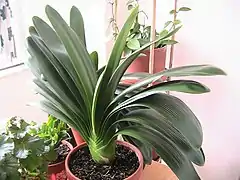
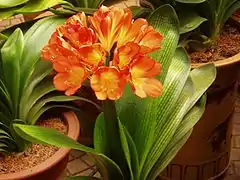

 Clivia miniata var. citrina
Clivia miniata var. citrina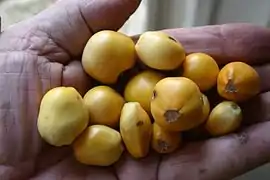 Clivia miniata var. citrina fruit
Clivia miniata var. citrina fruit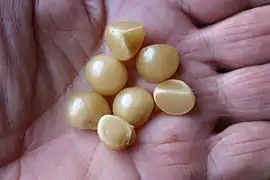 Clivia miniata var. citrina seed
Clivia miniata var. citrina seed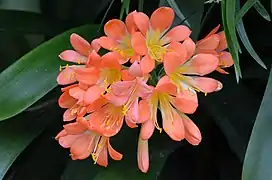 Orange flowered form
Orange flowered form
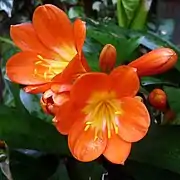
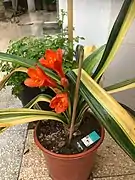
References
- "Clivia miniata". World Checklist of Selected Plant Families. Royal Botanic Gardens, Kew. Retrieved 2016-06-28.
- RHS A-Z encyclopedia of garden plants. United Kingdom: Dorling Kindersley. 2008. p. 1136. ISBN 978-1405332965.
- Kew World Checklist of Selected Plant Families
- "The Flowering Plants of South Africa; vol. 1/3". Retrieved 2021-03-25.
- "Information about Kaffir Lily". Archived from the original on 2017-02-05. Retrieved 2011-10-21.
- "Clivia miniata - PlantZAfrica". Retrieved 2021-03-25.
- "RHS Plant Selector - Clivia miniata". Retrieved 15 April 2020.
- "RHS Plant Selector - Clivia miniata var. 'citrina'". Retrieved 15 April 2020.
- "AGM Plants - Ornamental" (PDF). Royal Horticultural Society. July 2017. p. 22. Retrieved 24 January 2018.
- "Clivia miniata - Plant Finder". www.missouribotanicalgarden.org. Retrieved 2018-07-05.
- Hartigh 2013.
Bibliography
- Hartigh, Wilma den (17 January 2013). "Kirstenbosch celebrated in print". Media Club South Africa. Archived from the original on 17 November 2016. Retrieved 16 November 2016.
External links
- https://web.archive.org/web/20181103025333/http://cliviabase.co.za/
- http://www.blankees.com/house/plants/k_lily.htm
- http://www.plantzafrica.com/plantcd/cliviaminiata.htm